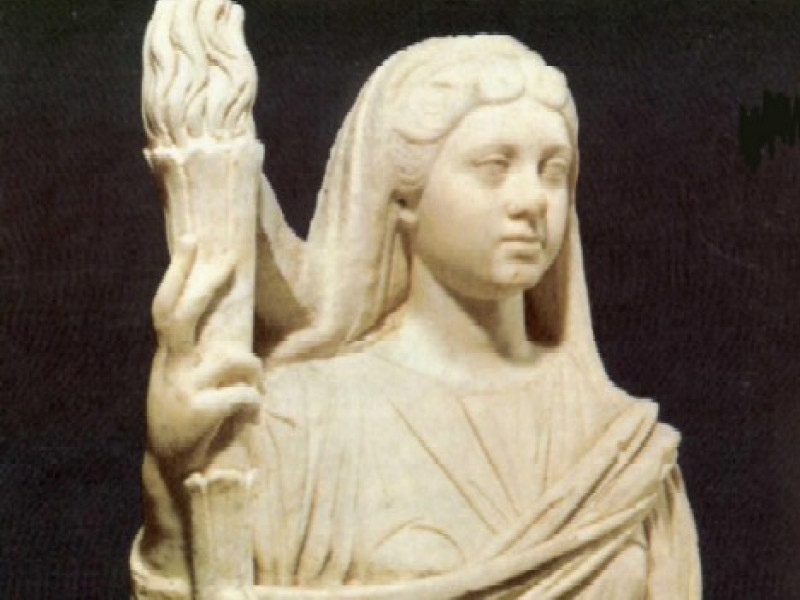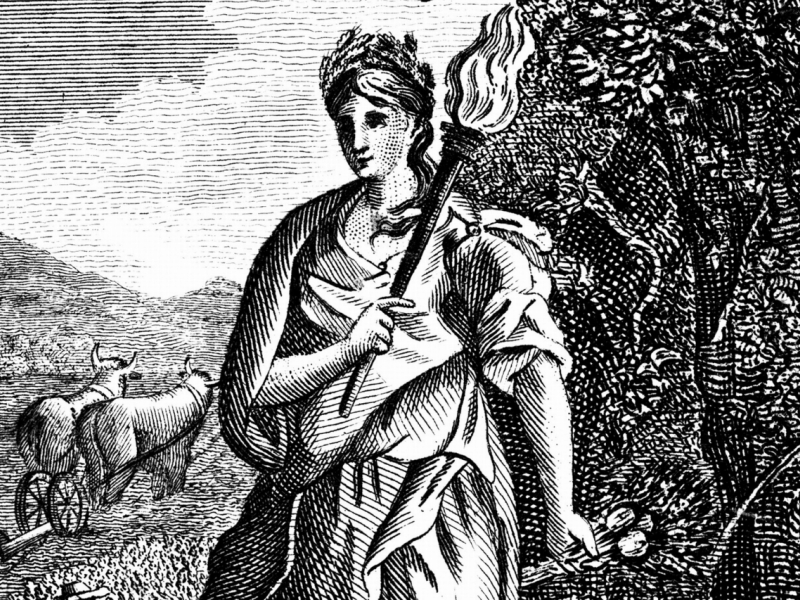Demeter
Goddess of corn or of the earth and fertility. Demeter was also known as Deo, while the Romans called her Ceres. Demeter was a daughter of Cronus and Rhea.
Demeter was often seen as one of the Olympians, replacing Hades since the Underworld god was rarely seen outside of his domain.
She became mother of Persephone by her brother Zeus.
One day while Persephone was playing with her companions, Hades came and abducted her. Hades had fallen in love with Persephone's great beauty. Hades wanted to marry her and make her his queen in the Underworld.
In her grief, Demeter searched the world for nine days, trying to find out how her daughter had vanished. No one knew who abducted her until she met Hecate and Helius.
When she discovered that Hades had abducted Persephone, she refused to allow plants and crops to grow. The entire world was facing starvation. Finally Zeus ruled that Persephone would spend two-thirds of a year with her mother on earth, while spending the rest of the year in the Underworld with her husband.
A more detailed account of the myth of Demeter and the abduction of her daughter can be found in the Mother Goddesses section under the title Demeter and Persephone.
It was during her search for her daughter that her other brother Poseidon tried to seduce her. She changed into a mare to hide from the sea-god, but Poseidon changed himself into a stallion and mounted her. According to the Arcadian legend, her ravishment happened in Arcadia, where she was known as Demeter Erinys (Demeter the Fury) and the Black Demeter. She gave birth to a daughter named Desponia, goddess of the horses, as well as the immortal horse Arion.
She also had a liaison with a mortal, Iasion, and became mother of Plutus and Philomelus. Plutus was one of the triad of deities worshipped in the Eleusinian Mystery of Demeter and Kore (Persephone).
Demeter was not always a kindly goddess. When she was searching for her daughter, wandering the earth as an old woman, she did cause crops to fail, particularly among those people who were inhospitable toward her.
Perhaps the most frightening of all was the story of Erysichthon. Demeter inflicted Erysichthon with unceasing hunger, which he could never satisfy. The agony of hunger caused Erysichthon, in the end, eat himself to death, quite literally – Erysichthon started eating his own flesh. See Erysichthon in the Wrath of Heaven.
Eleusis was the centre of her cult, but Athens took over the Eleusinian Mysteries. Demeter was usually depicted in the arts holding ears of corn, although sometimes she was holding a sceptre or torch.
Other important sites were Thelpousa and Phigaleia in Arcadia. The sea-god Poseidon raped the goddess while he was in the form of stallion and she was in the shape of mare. She gave birth to a goddess known only as Desponia, the Mistress; only the initiated of her mystery in Arcadia knew the true name of the goddess' daughter.
In Thelpousa, she was known as Demeter Eriyns, or "Demeter the Fury". In a sanctuary in Oncion there was a wooden image of her, depicting her holding basket in her left hand and torch in her right. She was also given the title of the Washing Demeter, because the goddess would walk to the Ladon river where she bathed when Poseidon lusted after her. There was a six-foot wooden statue of her as the Washing Goddess, but it was sometimes mistaken for the Titaness Themis.
At Phigaleia, there was a cave sacred to her. It was where she stayed after her rape, causing famine in Arcadia and elsewhere in Greece. Crops could not be grown and mankind was facing extinction. In this cave, she wore only black, which was why she was known as the Black Demeter. In this cave, it became her sanctuary, and there was a wooden image of her that showed her sitting on the rock. She may have had the body of a woman, but her head was that of a horse. She held a dolphin in one hand and dove in the other.
According to the Orphic myth, her real name is Rhea, daughter of Uranus and Gaea. She was a Titaness who became the consort of her brother Cronus. After Zeus was born, her name changed to Demeter. When Zeus raped his mother Rhea/Demeter, she gave birth to Persephone. Her daughter was also raped by Zeus so that Persephone was the mother of Zagreus or Dionysus.
Related Information
Name
Demeter, Δημήτηρ; Deo, Δηω – "Mother".
Da (pre-Hellenic?).
Cere (Roman).
E-RI-NU (Minoan could be epithet of Demeter?).
Demeter Erinyes – "Demeter the Fury".
The Washing Demeter.
The Black Demeter.
Rhea (in the Orphic myth).
Festivals
Scirophoria.
Thesmophoria.
Eleusinia.
Sources
Homeric Hymns.
Library was written by Apollodorus.
Metamorphoses was written by Ovid.
Fabulae and Poetica Astronomica were written by Hyginus.
Theogony was written by Hesiod.
The Iliad and the Odyssey were written by Homer.
Argonautica was written by Apollonius.
Hymns was written by Callimachus.
The Description of Greece was written by Pausanias.
Related Articles
See also Ceres.
See also Demeter and Persephone in the Mother Goddesses.
Cronus, Rhea, Persephone, Zeus, Hades, Poseidon, Hecate, Helius, Erysichthon.
By Jimmy Joe







